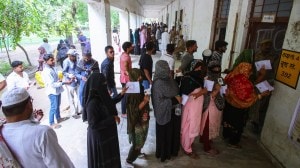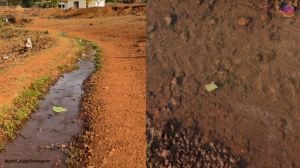- India
- International
IIT-B study: Mumbai’s urban footprint is growing faster than city’s population
Done using satellite images, the study says that the decline in population density of the urban areas is at the expense of cultivated lands, forests and water bodies.
 The study area also included a buffer of two kilometres from the boundary of this region to study the ecosensitive intertidal zone. (File Photo)
The study area also included a buffer of two kilometres from the boundary of this region to study the ecosensitive intertidal zone. (File Photo)
In the four decades from 1972 to 2011, the urban footprint of Mumbai has spread more rapidly compared to the city’s population growth, an IIT-Bombay study shows. During this time, the built-up area in the region increased 4.5 times, from 234 sqkm to 1,056 sqkm, while the population grew only three-fold, according to the study.
This urban sprawl has increased the infrastructure cost and commuting time, stressing transport networks and destroying forests and wetlands, says the study published in the journal Applied Geography. Done using satellite images, the study says that the decline in population density of the urban areas is at the expense of cultivated lands, forests and water bodies.
The researchers, Dr Priya Mendiratta and Professor Shirish Gedam, studied the spread of built-up area, densely covered by buildings, using archived Landsat images from 1972 to 2011. In the study, the researchers show how the digital interpretation of archived images and satellite data could provide a base plan to predict the “growth directions” in a metropolitan area.
This data was then used to identify the direction and rate of growth of the Mumbai Metropolitan Region, which consists of Greater Mumbai, Mumbai suburban districts and parts of Thane and Raigad districts. This region is among the most densely populated urban areas in the world. The study area also included a buffer of two kilometres from the boundary of this region to study the ecosensitive intertidal zone.
“Urban planners need a preview of availability of new resources so as to facilitate the growth of cities by addressing the patterns of changing land use and projecting their future growth to mitigate the negative impacts of urbanisation,” the study says.

In the case of Mumbai, the urban area has expanded towards Vasai-Virar in the north and Bhiwandi in the east along the Central Railway line on one side and across the Thane creek to Navi Mumbai on the other side. These three growth directions connecting the expressway leading to Pune in the southeast and Goa on the southwest encompass the Sanjay Gandhi National Park, the Matheran Eco-Sensitive Zone and the Karnala Bird Sanctuary, respectively.
According to the researchers, this expansion could be influenced by the state government’s policies, which are aimed at deterring growth in the centre of the city. The establishment of industries has led to dense urbanisation along the Thane creek, where foothills were cut and low-lying marshy lands have been filled up.
“We can observe the growth directions in order to identify potential growth centres in the region and optimally utilise the available natural resources and better conserve the fragile ecology there,” says Dr Mendiratta. “While promoting growth in a particular direction, it is likely that decision-makers may overlook environmental conservation or utilisation of public money and/or natural resources.”
Apr 26: Latest News
- 01
- 02
- 03
- 04
- 05































